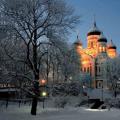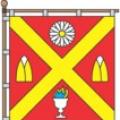Tallinn Alexander Nevsky Cathedral. Alexander Nevsky Cathedral Temple of Alexander Nevsky in Tallinn schedule of services
- Address: Lossi plats 10, 10130 Tallinn, Estonia;
- Opening: 1900;
- Architectural style: Pseudo-Russian style;
- Telephone: +372 644 3484;
- Website: tallinnanevskikatedraal.eu;
- Architect: Mikhail Timofeevich Preobrazhensky.
There are a lot of cathedrals dedicated to the great commander, Alexander Nevsky, on the territory of the former Russian Empire. One of the most famous and majestic is located in the capital. The temple is considered quite young; it has only one significant anniversary – 100 years, which was celebrated in 2000.
Alexander Nevsky Cathedral - description
The construction of the new cathedral was facilitated by the active growth of the Orthodox population. The small Transfiguration Church could no longer accommodate all the parishioners. The initiator of collecting donations for the new temple was Prince Sergei Shakhovskoy. At first, they were reluctant to donate money, but the situation changed dramatically after one event - the miraculous rescue of Tsar Alexander III from a train accident. In October 1888, the sovereign was returning from Crimea. Suddenly the train suddenly derailed. The roof of the carriage in which the royal family was traveling began to collapse. But the king was not taken aback, he courageously supported her with his shoulders and held her until all the members of his family and servants got out. In that terrible accident, more than 20 people died and about 50 were injured. The Orthodox considered this a sacred sign. They were convinced that the king's patron saint had saved his family at that time. Therefore, it was decided to name the new cathedral in honor of Alexander Nevsky. After this, money for the temple began to be collected much more actively. The total amount of donations amounted to almost 435 thousand rubles.

In 1893, on the square in front of the governor's palace, the site for the future church was solemnly consecrated. As a sign of this, a large wooden cross 12 fathoms high was erected here and a firework was given. The creation of the project was entrusted to academician Mikhail Preobrazhensky. Looking at the photo of the Alexander Nevsky Cathedral in Tallinn, one cannot help but notice how much it stands out from the surrounding city buildings, which are made mainly in the Gothic style. Its graceful onion domes have become a striking architectural accent in the overall panorama of the city.

In April 1900, the doors of the new Orthodox church opened to parishioners. Today it represents a grand example of Tallinn's Orthodox sacral architecture.
The Alexander Nevsky Cathedral is decorated with painted mosaic panels; the interior decoration amazes with its beauty and grandeur. The church contains three gilded wooden iconostases and four icon cases. All of them were made by the same master who gilded the domes of the temple - S. Abrosimov. The basis for the work was the sketches of the chief designer of the cathedral, Mikhail Preobrazhensky.
The most powerful bell ensemble in Tallinn is also assembled here, consisting of 11 bells, including the largest bell in the capital weighing 15 tons.
 Tourist Information
Tourist Information
- Alexander Nevsky Cathedral in Tallinn is open daily from 8:00 to 19:00;
- entrance to the temple is free;
- beginning of the morning liturgy: at 8:30 (Monday to Friday), at 9:00 (on weekends);
- the main language of worship is Russian;
- Liturgies are held in Estonian on Saturdays (starting at 11:00);
- It is better not to visit the Alexander Nevsky Cathedral from 10:00 to 12:00 (baptismal rites usually take place here at this time);
- You cannot come to the temple in revealing or provocative clothing (shorts, T-shirts, short skirts);
- women should cover their heads before entering the cathedral;
- in the souvenir shop you can buy icons, calendars, prayer books, candles and other Christian attributes;
- There is a special donation box near the second church door.

Where is the Alexander Nevsky Cathedral located?
The temple is located on Lossi (Freedom) Square 10. If you come by train, you can walk from the station to this church in 15 minutes.
Convenient access from Toompuieste Boulevard. Walking up from Kaarli Church along Toompea Street, you will come across the Alexander Nevsky Cathedral, which is located opposite.
There is another option - approach from Freedom Square. After passing the stairs, which are located behind the “glass cross” and moving further along, you will reach Toompea Street. Then the route is known to you - up to the end.
(Puha Aleksander Nevski katedraal) - the largest church building in the entire Baltics - is located on the Toompea hill dominating the city and is the cathedral Orthodox cathedral church of the Estonian Orthodox Church, subordinate to the Moscow Patriarchate. Currently, the rector of the cathedral is Metropolitan Cornelius (Jacobs) of Tallinn and All Estonia. Its domes soaring in the sky are visible from almost all points of old Tallinn.
The Alexander Nevsky Cathedral in Tallinn was built by 1900 in memory of the miraculous salvation of Emperor Alexander III during the terrible crash of the imperial train on October 17, 1888. Donations for the construction of the temple were collected throughout the Russian Empire, and the choice of a site for construction dragged on for several years, until finally, by the highest decree, it was decided to build a cathedral in the neo-Byzantine style with onion domes in the Upper Town of Tallinn, on Toompea Hill.
In Soviet times, they tried to convert the Alexander Nevsky Cathedral in Tallinn into a planetarium, but it was saved, according to rumors, by Patriarch Alexy II himself, a native of Estonia. The cathedral has been perfectly preserved to this day and is rightfully considered one of the most beautiful churches not only in Tallinn, but throughout the Baltic states.

The cathedral in Tallinn was named in honor of the Holy Blessed Prince Alexander Nevsky, who defeated the knights of the Livonian Order in the Battle of the Ice on Lake Peipsi and saved northwestern Rus' from the danger of German colonization and forced conversion to Catholicism, for which the prince was canonized.

The five-domed, three-altar cathedral, which seats 1,500 parishioners, is known for its rich interior decoration, extraordinary altar and unique collection of icons. The icons for the cathedral were painted in the workshop of academician of painting Alexander Novoskoltsev; based on his sketches, St. Petersburg master Emil Steinke made stained glass windows with images of the Savior, the Mother of God and John the Baptist, which can be seen in the altar windows of the main chapel.
One of the decorations of the Alexander Nevsky Cathedral in Tallinn is considered to be two bronze gilded chandeliers in the side aisles of the cathedral. They were modeled after the famous chandelier of the Church of the Savior on Bor in the Moscow Kremlin.
On the walls on both sides of the main entrance there are two marble memorial plaques - one about the construction of the temple and the second about its consecration. Later, plaques were installed in the Alexander Nevsky Cathedral in Tallinn in memory of Russian soldiers and sailors who died in various battles.
The majestic Alexander Nevsky Cathedral in Tallinn is the largest Orthodox cathedral in the capital of Estonia. Officially, it is a stauropegic cathedral Orthodox cathedral church under the jurisdiction of the Estonian Orthodox Church of the Moscow Patriarchate (since March 1999). The church is located on the hill of Toompea (Vyshgorod).
The cathedral is a five-domed, three-altar cathedral, modeled on Moscow churches built in the 18th century. Designed for 1500 parishioners. The height of the cathedral is about 58 meters. This is one of the important attractions in the center of Tallinn. First of all, tourists from Russia try to get here.
The temple is distinguished by majestic domes; inside you can see amazing mosaics and many unique icons. The cathedral's bell ensemble of 11 bells is intended to remind everyone of the victory of Alexander Nevsky over the knights of the Livonian Order, when the German army was defeated by the Russian prince on April 5, 1242 on the ice of Lake Peipsi.
It was originally planned that a marble iconostasis would appear in the cathedral. However, it was not possible to find money for it, so instead they installed a wooden one with gilding. By the way, all three iconostases of the cathedral, as well as four icon cases, were made according to the sketches of Mikhail Preobrazhensky himself. The icons for the iconostasis and icon cases were painted on zinc and copper boards in St. Petersburg, in the workshop of Academician A. N. Novoskoltsev. The work on creating icons lasted from 1889 to 1899.
The current rector of the cathedral is Metropolitan Cornelius (Jacobs) of Tallinn and All Estonia.
History of the Alexander Nevsky Cathedral in Tallinn
The temple was built at the very beginning of the 20th century, in 1900, according to the design of the famous Russian architect Mikhail Preobrazhensky. The decision to begin construction was made immediately after the famous train accident that occurred on October 17, 1888, which involved the family of the Emperor of the Russian Empire Alexander III and the emperor himself. It was in memory of the miraculous salvation of the imperial family that they decided to build a majestic temple. Fundraising took place both directly in Russia and in Estonia.
The site for the construction of the cathedral on the square in front of the governor's palace (now the parliament building is located here) was named the best of the eight proposed.
Already on August 20, 1895, the foundation stone of the church was consecrated. In 1897, gilded iron crosses were installed on the domes of the cathedral. The gilding of the domes themselves was completed in 1898. The bells for the temple were made at the bell factory in St. Petersburg, and they were installed in the same 1898. The temple was consecrated on April 30, 1900.
It is known that during the years of Soviet power the cathedral was planned to be demolished several times. So, in the 1920s, the communists raised money to destroy the “monument of Russian violence” (as they called it then), but there were clearly not enough people willing to take part in this with rubles. During World War II, the temple was temporarily closed, and after the war they again started talking about blowing it up. In the 1960s, the leadership of the USSR wanted to build a planetarium inside the cathedral (as was done with the Nativity Cathedral in Riga), but parishioners led by Bishop of Tallinn and Estonian Alexei Ridiger opposed this. It was his efforts that allowed the cathedral to exist to this day.
How to get to Alexander Nevsky Cathedral in Tallinn
The temple is located in the central part of Tallinn, so you most likely will not have any problems getting here.
Getting to the cathedral is quite easy by public transport. The nearest stop is called Hotell Tallinn. Buses No. 4, 5, 21, 21B, 41, 41B, 43 and 59 stop here. From the stop to the cathedral you will need to walk about 500 meters. This is no more than 10 minutes at a leisurely pace. You can also get off at the Vabaduse väljak stop. Buses No. 9, 16, 21, 21B, 41, 41B, 46 and 48, as well as trams No. 3 and 4 go here. The stop is located approximately 600 meters from the temple.
As for a taxi, this is also a very convenient way to get around Tallinn and the fastest option to get to the cathedral. You can order a taxi through your smartphone. All you need to do is download the app from one of the popular services, like Uber or Gett. You can also use local taxis in Tallinn. Among the most popular companies are Sobra Takso, Amgio Takso and Tulika Takso. The cost of taxi trips in Tallinn is significantly lower than in Western Europe, but generally higher than in Russia. In any case, do not forget to make sure that the driver turns on the meter or negotiate the amount of the trip in advance. Otherwise, there is a high risk of paying significantly more than it actually costs.
Panorama of Alexander Nevsky Cathedral in Tallinn:
Video:
Completed in 1900 according to the design of the architect Preobrazhensky.
Story
Built in 1900 in memory of the miraculous rescue of Emperor Alexander III in a train accident on October 17, 1888. Of the eight proposed options for the construction of the cathedral, the best place turned out to be the square in front of the governor's palace (now the parliament building).
On February 19, 1887, the Orthodox clergy of Tallinn submitted a memo to the Estonian governor, Prince Sergei Vladimirovich Shakhovsky, which explained the need to build a new cathedral. The Synod recognized the construction of a new temple as truly necessary and allocated 60 thousand rubles. At the request of the governor, on April 2, 1888, Emperor Alexander III gave permission to collect donations within the Russian Empire.
Major problems and unforeseen costs arose for the committee for the construction of a new cathedral when deciding on the choice of location. This issue was discussed from April 1888 to mid-1892. The committee was offered eight options, the most suitable was the area in front of the governor's palace (now the Estonian Parliament building)
On August 20, 1895, the foundation stone of the cathedral was consecrated. Two years later, on November 2, 1897, thanks to the efforts of the main contractor, merchant of the first guild Ivan Dmitrievich Gordeev, gilded iron crosses were solemnly installed on the domes of the cathedral.
The gilding of the domes of the temple was carried out during the middle of 1898 by the master and merchant of the second guild - Pyotr Semenovich Abrosimov. The bells for the new temple were made at the bell factory of the merchant Vasily Mikhailovich Orlov in the capital of the Russian Empire - e. Their total number was eleven bells. The event to consecrate and install the bells took place on June 7, 1898. Initially, the design of the new temple included the installation of a marble iconostasis, but during the construction of the cathedral, it was decided to replace it with a gilded wooden one. This work was entrusted to Peter Abrosimov. The icons were painted in the workshop of academician of painting Alexander Nikanorovich Novoskoltsev. According to his design, stained glass windows were made by St. Petersburg master Emil Karlovich Steinke, which were then installed in the windows of the altar. The five-domed three-altar cathedral, designed for 1,500 people, was built on the model of Moscow churches of the 17th century. The facades of the cathedral are decorated with mosaic panels made by academician of architecture A. Frolov.
The temple was solemnly consecrated on April 30, 1900 by His Grace Agafangel (Preobrazhensky), Bishop of Riga and Mitau; Fr. participated in the consecration. John of Kronstadt. The Russian parish from the Transfiguration Cathedral moved to the new cathedral; the latter was transferred to the ethnically Estonian community. The first rector in 1900-1909 was Archpriest Simeon Popov.
For ideological and political reasons, the authorities planned to demolish the temple in 1924, during the period of Estonia’s first independence. An active defender of the cathedral was the Primate of the Estonian Apostolic Orthodox Church, Metropolitan Alexander (Paulus), who in 1936 moved his see here from the Transfiguration Cathedral. At the end of 1936, Archpriest N. Päts, brother of the President of the Republic of Estonia K. Päts, became the rector of the cathedral.
During the period when Estonia was part of the Reichskommissariat Ostland of the German Empire, the temple was closed.
In the early 1960s, they tried to rebuild the cathedral into a planetarium, but it was saved, according to a version actively promoted during the Patriarchate of Alexy II, but without any documentary evidence, by Bishop Alexy (Ridiger), later Patriarch Alexy II.
On September 3, 1961, the cathedral hosted the episcopal consecration of Archimandrite Alexy (Ridiger), led by Archbishop Nikodim (Rotov) of Yaroslavl and Rostov.
Later history and modern times
On March 6, 1999, the parish charter was registered with the Estonian Ministry of Internal Affairs. The cathedral received the status of stavropegial; the parish was endowed with the status of the official representation of the Moscow Patriarchate in Estonia with the retention of the chair of the Primate of the EAOC of the Moscow Patriarchate.
The rector of the cathedral is Metropolitan Cornilius (Jacobs) of Tallinn and All Estonia.
Icons
Mikhail Preobrazhensky’s original design for the cathedral included a marble iconostasis, but during the construction process, due to cost savings, it was replaced with a gilded, wooden one, since compared to the marble one, this one was cheaper and more suitable for the type of cathedral built according to the type of Moscow churches of the 17th century.
 Alexander Nevsky Cathedral Temple of Alexander Nevsky in Tallinn schedule of services
Alexander Nevsky Cathedral Temple of Alexander Nevsky in Tallinn schedule of services Satellite map of the Trans-Baikal Territory Detailed physical map of the Trans-Baikal Territory
Satellite map of the Trans-Baikal Territory Detailed physical map of the Trans-Baikal Territory Andrushevka Zhytomyr. Andrushevka. The park also has a peninsula surrounded by an artificial water channel. Its abandoned remains remain
Andrushevka Zhytomyr. Andrushevka. The park also has a peninsula surrounded by an artificial water channel. Its abandoned remains remain